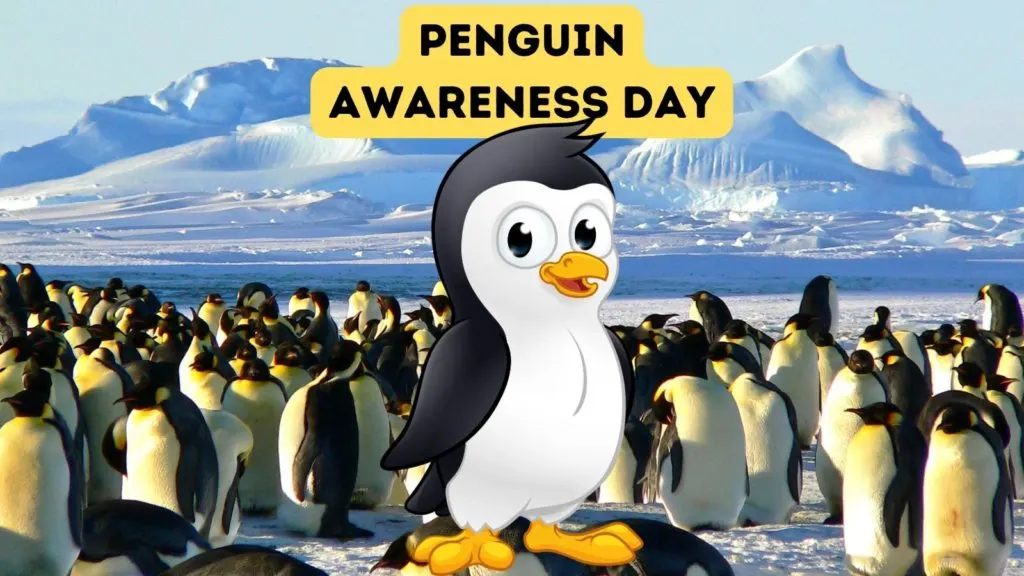Penguin Awareness Day is an excellent opportunity to learn more about these fascinating birds and to appreciate their unique qualities. While penguins are quite different from the birds we commonly see in our backyards, there are also surprising similarities!

When is Penguin Awareness Day?
Penguin Awareness Day is celebrated every year on January 20.
Penguins are also recognized every year on World Penguin Day.
Similarities between Penguins and Backyard Birds
While at first glance, it seems like penguins could not be more different than the birds you see at your bird feeder, there are several similarities!
Bird Classification: Like our backyard birds, penguins are part of the bird family. They are warm-blooded, feathered, and lay eggs.
Feathers: Penguins have feathers, just like all other birds. Their feathers are specialized for swimming but serve the same purpose of insulation and waterproofing.
Parental Care: Penguins are devoted parents, similar to many backyard birds, often taking turns incubating eggs and feeding their chicks.
Social Behavior: Both penguins and many backyard bird species exhibit social behaviors, living and interacting in groups.
Vocal Communication: Penguins communicate with each other using vocalizations, much like the birds we hear chirping and singing outside our windows.
Territoriality: Some penguin species are territorial during breeding season, akin to many backyard birds who defend their nesting areas.
Annual Molt: Like backyard birds, penguins go through an annual molt, shedding their feathers to replace them with new growth.
Diet: Penguins primarily eat fish and crustaceans, which is similar to backyard birds that are also often omnivorous, albeit their diets consist of different types of food.
Predator Evasion: Penguins, like smaller birds, have various strategies to evade predators, including swift swimming and group safety tactics.
Bipedal Stance: Penguins stand on two legs, similar to how most backyard birds perch.
Differences between Penguins and Backyard Birds
Of course, part of what makes penguins so endearing is their uniqueness and the many ways they differ from the birds we see around our homes!
Flight: The most obvious difference is that penguins cannot fly, unlike backyard birds. They are adapted for swimming instead.
Habitat: Penguins are primarily found in the Southern Hemisphere, with many species living in Antarctica.
Swimming Ability: Penguins are excellent swimmers and spend a significant amount of their lives in water, using their flippers to propel themselves. Like ducks, they’re aquatic birds but penguins use their flippers for propulsion underwater, while ducks paddle with their webbed feet.
Body Structure: Penguins have a unique body structure with a more robust and streamlined build for swimming, which differs significantly from the lighter, air-worthy bodies of flying birds. Penguins have legs set far back on their bodies, aiding in swimming but resulting in their upright, waddling gait on land. Ducks have more centrally located legs, allowing for more efficient movement on land.
Thermoregulation: Penguins are adapted to cold environments, with layers of fat and dense feathers for insulation.
Breeding Colonies: Penguins often breed in large colonies, some numbering in the thousands!
Life Span: Penguins generally have a longer lifespan compared to many backyard birds, with some species living up to 20 years or more.
Feeding Techniques: Penguins dive and hunt for their food in the ocean, a method of feeding that is vastly different from the foraging habits of backyard birds.
Size: Penguins range in size from the small blue penguin, which is about the size of a large duck, to the emperor penguin, which can stand nearly four feet tall, making them generally larger than most backyard bird species.
Migration Patterns: While some backyard birds migrate long distances, penguin migrations are typically different, involving movements within and between oceanic feeding grounds and breeding sites, rather than the long-distance aerial migrations seen in many flying birds.
Penguin Awareness Day is a great time to appreciate these unique and fascinating birds, recognizing both their similarities to and differences from the birds we see more commonly. Understanding and celebrating this diversity in the avian world enhances our appreciation of all bird species and the various roles they play in our global ecosystem.
More Bird Days You Might Enjoy
BirdTipper features dozens of bird days throughout the year including these you might enjoy:
- 8 Letter Bird Names - August 14, 2024
- 7 Letter Bird Names - August 14, 2024
- 7 Birds Named After Famous People - July 23, 2024
